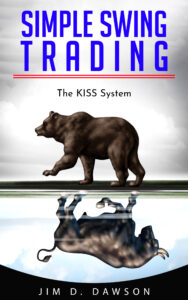Swing trading can be one of the most rewarding forms of investing. With its potential to offer gains in a short time period, more and more investors are turning to this form of trading. Although this type of trading involves taking higher risks, those who understand it have the potential to make large profits. This article will explain what swing trading is and how you can benefit from it.
What is Swing Trading in Layman’s Terms?
Swing trading is an investment strategy that can be used to generate profits in the stock market. It involves taking advantage of short-term price movements without exposing yourself to too much risk. In layman’s terms, swing trading is a way to make money by buying and selling stocks over a period of days or weeks.
risk. In layman’s terms, swing trading is a way to make money by buying and selling stocks over a period of days or weeks.
The key to successful swing trading is to identify when the price of a stock is likely to move in one direction or the other. To do this, swing traders use technical analysis tools such as trend lines, moving averages, and support/resistance levels. These tools help traders identify potential entry and exit points in the market, allowing them to capitalize on short-term price movements for maximum profit.
Swing trading is an attractive strategy for many stock traders because it does not require a large capital outlay, and offers the potential for quick profits in a relatively short period of time. With the right approach, swing trading can be a profitable and rewarding endeavor.
A. Defining Swing Trading
Swing trading is a popular trading strategy that involves taking advantage of short-term price movements in the stock market. The goal of swing trading is to identify potential buying and selling opportunities within a time frame of several days or weeks. It is different from day trading, which is usually done within a single day, or scalping, which is typically done within minutes.
Swing trading is a good option for traders who want to participate in the stock market but don’t have the time or resources to track the market on a daily basis. By utilizing swing trading strategies, traders can take advantage of price movements within a shorter period of time and increase their chances of successful trades.
To be successful at swing trading, it’s important to understand how to identify potential entry and exit points in the market. Traders should also be aware of the various factors that can influence the price of a security, such as news reports and economic data releases. Additionally, traders should be aware of the risks associated with swing trading and should use appropriate risk management techniques to limit their losses.
By using swing trading strategies, traders can take advantage of both short-term profits and long-term investments. Swing trading is an ideal option for traders looking to capitalize on the stock market without dedicating too much time or effort. With the right knowledge and approach, swing trading can be a great way to make money in the stock market.
LET US HELP YOU LEARN TO SWING TRADE
B. Analyzing the Market
Swing trading is a popular form of active trading which uses various forms of technical analysis to identify intermediate-term opportunities. Swing traders look for potential trades, assess them on a risk/reward basis, and then set entry and exit points with a stop loss in place. Technical analysis tools such as moving averages, momentum indicators, price range tools, and measures of market sentiment are used by swing traders to help identify potential trades. Common technical patterns such as head-and-shoulders and cup-and-handle are also looked out for to help identify potential trades. Fundamental analysis can also be used to enhance the analysis. By assessing the fundamentals of an asset and verifying that they look favorable or are improving, it helps to improve the chances of making a successful trade.
C. Identifying Price Movements
Identifying price movements is an integral part of successful swing trading. Understanding technical analysis, reading the news and developing a trading strategy are all necessary components for effective identification of price movements in the markets.
Technical analysis involves the use of charts and indicators to identify patterns and trends in the market. By properly understanding how these tools work, you will be better equipped to spot price movements in the market. Additionally, it is useful to read the news and be on the lookout for potential news-based events that may affect the price of a security. This form of analysis can provide valuable insight into the direction of the markets and help you make informed decisions about when to buy and sell securities.
Finally, it is important to develop a trading strategy that incorporates both technical analysis and news-based events. By doing this, you will be able to identify the best times to buy and sell securities and maximize your profits. It is important to remember that while swing trading is a great way to make money, it is also risky and should not be attempted without proper research and preparation.
What Are Some Indicators or Tools Used by Swing Traders?
Swing trading is a type of trading strategy that seeks to capitalize on short-term stock price movements. As a swing trader, you need to be aware of the various indicators and tools available to help you make informed decisions.
One of the most commonly used technical indicators by swing traders are moving averages. Moving averages are used to identify trends in the market by smoothing out short-term fluctuations. They can help traders identify the direction of a trend and decide when to enter or exit a trade.
Oscillators are another popular tool for swing traders. Oscillators are used to identify overbought and oversold conditions in the market. This helps traders gauge when a market is overbought and may soon drop, or when it is oversold and may soon rise. Momentum indicators are also useful as they measure the strength of a trend. By using momentum indicators, swing traders can get an idea of how strong a trend is and whether it is likely to continue.
Overall, there are many different indicators and tools available to swing traders. By understanding and utilizing these indicators and tools, traders can become better equipped to make informed trading decisions.
A. Technical Analysis
Technical analysis is an invaluable part of successful swing trading. By understanding the past price movements and trends, traders can gain insight into future price movements. Technical analysis relies heavily on technical indicators such as moving averages, support and resistance levels, as well as trend lines.
Learning how to read and interpret technical analysis is essential for any aspiring swing trader. By studying the history of a given asset, you can make more informed decisions about when to enter and exit trades. Understanding these indicators can help you hone your skills and become a more successful swing trader.
In order to make the most out of technical analysis, traders should have a comprehensive understanding of the different types of technical indicators available. Moving averages, for example, are used to measure the average price of an asset over a certain period of time. Support and resistance levels indicate areas of support or resistance for an asset’s price. Trend lines are also important, as they show the direction of the market.
By studying the history of a given asset and using technical indicators, swing traders can make more informed decisions when entering and exiting positions. Technical analysis is a key component of successful swing trading and can be used to unlock the secrets of success.
B. Moving Averages
Moving averages are a popular indicator used by swing traders to gauge the direction and strength of price movements. By analyzing the average price of an asset over a specified period of time, swing traders can identify trends, locate support and resistance levels, and determine when to enter and exit trades.
One of the most important benefits of using moving averages is that they help smooth out price fluctuations, making it easier to spot potential trading opportunities. This is especially useful for swing traders, as they often make trades over a relatively short period of time. Moving averages can also be used to identify support and resistance levels, which can help swing traders make more informed trading decisions.
Swing traders use moving averages to determine when to enter and exit trades, which can help them maximize their profits. By analyzing the trend of an asset’s price over a particular period of time, swing traders can identify the best times to buy or sell, allowing them to take advantage of maximum profit potential. Additionally, swing traders can use moving averages to confirm their trading decisions and protect themselves against potential losses.
Using moving averages can be a valuable tool when swing trading. By utilizing moving averages, traders can identify trends, locate support and resistance levels, and determine when to enter and exit trades. This can help swing traders maximize their profits and minimize their risks.
C. Support and Resistance Levels
Support and resistance levels are key concepts in swing trading and play an important role in helping traders make profitable trades. These levels are prices at which buyers have been willing to buy (support levels) or sellers have been willing to sell (resistance levels). Identifying these levels on a chart can help traders find potential entry and exit points for trades.
By understanding and recognizing support and resistance levels, traders can potentially increase their chances of making a profit. Additionally, these levels can assist with managing risk by indicating when it may be time to take profits or cut losses.
Learning how to identify support and resistance levels is an essential skill for successful swing trading. There are several tools available to help traders recognize these levels, such as trend lines, Fibonacci levels and moving averages. By using these tools, traders can identify where prices may reverse or break out and develop a better understanding of the market.
In conclusion, support and resistance levels are important concepts in swing trading and can provide guidance to traders in identifying potential entry and exit points, and managing risk. By learning how to identify and use these levels, traders can improve their chances of making profitable trades.
Trend Following Swing Strategies
Trend following swing strategies are a great way to capitalize on any market trend. By analyzing the overall trend of the market and looking for entry points, where the price is likely to move in the direction of the trend, you can take advantage of potentially profitable opportunities.
For example, if the overall trend of the market is upwards and you identify an entry point that signals the price is likely to continue moving up, you can enter a trade with the expectation of making money.
Swing trading also allows traders to identify potential support and resistance levels. For example, if the overall trend is downwards but the price is at a level where there is strong support, you may be able to enter a long position in the hope of profiting from the upward momentum.
The beauty of swing trading is that it offers traders the flexibility to adjust their strategies according to market conditions. For example, if the overall trend of the market is sideways, you may choose to day trade or scalp the market to capitalize on any short-term price movements.
Swing trading also allows traders to have more control over their risk. By analyzing the market conditions, traders can set stop loss orders to protect their capital and limit their losses if the price moves against their position.
By taking advantage of the market’s natural swings, trend following swing strategies provide traders with the opportunity to capitalize on any market trend. With the right analysis and strategy, traders can take advantage of potentially profitable opportunities and have more control over their risk.
Momentum Trading
Momentum trading is a popular form of swing trading that focuses on taking advantage of short-term price movements in the stock market. Momentum traders look for stocks that are moving up in price quickly and attempt to capitalize on the momentum by buying shares and selling them when the prices start to fall. This form of trading is attractive due to the potential for large profits in a short period of time.
price quickly and attempt to capitalize on the momentum by buying shares and selling them when the prices start to fall. This form of trading is attractive due to the potential for large profits in a short period of time.
However, momentum trading also carries with it more risk as the stock prices can change very quickly and unpredictably. Momentum traders must be able to react quickly and make decisions based on their analysis of the market. They must also have an understanding of the fundamentals of the stock in order to make informed decisions. Additionally, momentum traders should always use stop-loss orders to protect their investments from unexpected losses.
Overall, momentum trading can be a great way to profit from short-term price movements in the stock market. However, it is important to understand the risks associated with this type of trading and make sure to practice proper risk management. By following these tips, you can unlock the potential of momentum trading and capitalize on the benefits of swing trading.
Reversal Trading
Reversal trading is a popular strategy used by swing traders that can help you stay ahead of the market and maximize profits. By identifying reversals in the stock market, you can buy or sell stocks at the right time in order to capitalize on potential opportunities before they pass you by.
It’s important to remember that reversal trading involves risk. By carefully selecting trades, you can limit your exposure to potential losses while still taking advantage of profitable opportunities. With careful analysis and research, you can unlock the secrets of this trading strategy and use it to your advantage.
Reversal trading can be a powerful tool for swing traders. It helps you stay up-to-date on the markets, allowing you to identify reversals before the rest of the market does. This can give you an edge when it comes to making the right decisions and maximizing profits. By researching different reversal trading strategies, you can begin to understand how to make the most of this trading technique.
Unlock the secrets of swing trading and discover the benefits of reversal trading today! With the right research and analysis, you can start to understand how to capitalize on potential opportunities and manage risk more effectively. Start taking advantage of this powerful trading strategy and reap the rewards now!
LET US HELP YOU LEARN TO SWING TRADE
Breakout Trading
Breakout trading is a popular swing trading strategy that can be used to capitalize on short-term price movements. This strategy looks for stocks that are breaking out of their trading range and trying to make a move. When the market is in an uptrend, breakout trading can be a great way to take advantage of short-term trends and make profits in a short period of time.
Before engaging in breakout trading, it’s important to do some research into the fundamentals of the stock and find positive technical indicators. These can help traders identify which stocks are likely to break out of their trading range and move in the right direction. Additionally, traders should use stop losses and money management techniques to minimize risk.
Breakout trading can be a profitable strategy, but it is important to understand the risks associated with it. It is essential to do your research and know when to enter and exit trades. With the right strategies and knowledge, breakout trading can be a great way to capitalize on short-term price movements and make profits.


